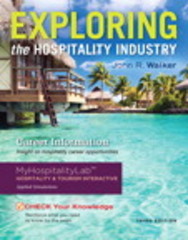Question
Placement in the Course The Peppercorn Dining case is one of several cases at the end of Part 2 in the text. The Part 2
Placement in the Course The Peppercorn Dining case is one of several cases at the end of Part 2 in the text. The Part 2 chapters have described the fundamental processes of organization development, including entry and contracting, data gathering, data feedback, intervention design, and evaluation. The Peppercorn case is rich in detail around how a small group of consultants began an OD process and collected a broad range of data. It is a very action oriented case in that it ends at a natural breakpoint in the OD processa set of data has been gathered, needs to be analyzed, and a process for feeding back the date needs to be designed. It is a good case to give students a chance to think through these issues, propose some alternatives, and discuss the pros and cons of different approaches. (Note: If this type of case is appealing to the instructor, the B. R. Richardson Timber Products Corporation case in the Integrative Cases section at the end of the text has a similar structure.) Peppercorn Dining is a restaurant on the All-American University campus and serves students who have purchased "meal plans" as well as cash-paying customers. A group of consultants from Square One Consulting was having lunch at Peppercorn when they bump into Drew, Peppercorn's manager. One of the consultants, Erica, worked at Peppercorn as a student. Based on this chance meeting, Drew describes the situation at Peppercorn as he sees it and they eventually reach an agreement to do some operational auditing. After several days, the group of three consultants, Roger, Lynn, and Erica, collect data from managers at the restaurant, representatives from the parent dining organization for the university, and from various student, full time, and temporary employees. Their interviews cover various operations functions, including serving, the kitchen, cashiers, dishwashers, and supplies. Toward the end of the first day of observations and interviews, Erica describes a new development, the announcement that the university will be constructing a new dining facility and that Drew will be the head of the new unit. The consultants complete their interviews and observations and must make sense of the data collected as well as think through the purpose and design of a feedback session where Drew will hear about their conclusions and recommendations. Instructions:
- Scenario: Your task is to make a change management plan to ensure a smooth transition and successful adoption of the new technology or change in your selected case study. ( Refer to the case you have chosen in class)
- Analysis: a) Conduct a thorough analysis of the change by considering the technological upgrade's scope, depth, and overall size. b) Identify the key stakeholders and affected departments within the organization. c) Analyze the potential impact of the change on employees, job roles, processes, and overall business operations.
- Objectives: a) Define clear and measurable objectives for the change initiative. b) Ensure that the objectives align with the strategic goals and vision of the Corporation you have chosen.
- Change Management Strategies: a) Develop strategies to address the identified challenges and potential resistance to change. b) Propose effective communication strategies to keep employees informed throughout the change process. c) Determine appropriate training and development programs to ensure employees have the necessary skills to adapt to the new technology. d) Recommend methods for involving and engaging employees in the change initiative. e) Consider strategies to address any potential cultural or organizational barriers to change.
- Roles and Responsibilities: a) Identify the key roles and responsibilities of individuals involved in the change management process. b) Define the role of leaders, managers, and change champions in driving and supporting the change initiative. c) Determine the communication channels and methods for effectively disseminating information to employees and stakeholders.
- Change Implementation Plan: a) Create a detailed plan outlining the steps and timeline for implementing the technological upgrade. b) Consider factors such as the sequencing of activities, resource allocation, and potential risks. c) Develop a change readiness assessment to evaluate the organization's preparedness for the change and identify areas that require additional attention.
- Monitoring and Evaluation: a) Establish methods for monitoring the progress of the change initiative. b) Develop metrics and indicators to measure the success and effectiveness of the change management plan. c) Outline strategies for addressing any issues or challenges during the implementation phase.
- Conclusion: Write a concise summary highlighting the key elements of your change management plan and the anticipated benefits of implementing the plan.
Format and Submission Guidelines:
- The change management plan should be presented in a professional report format.
- Ensure clear headings and subheadings are used to organize the content.
- Include an introduction providing background information about the Corporation and the context of the change initiative.
- Each section should provide a detailed explanation of the proposed strategies, methods, and actions.
- Use appropriate references and citations to support your arguments and recommendations.
- The assignment should be typed and properly formatted.
- Submit the assignment by the given deadline and upload it in Canvas electronically.
Step by Step Solution
There are 3 Steps involved in it
Step: 1

Get Instant Access to Expert-Tailored Solutions
See step-by-step solutions with expert insights and AI powered tools for academic success
Step: 2

Step: 3

Ace Your Homework with AI
Get the answers you need in no time with our AI-driven, step-by-step assistance
Get Started


